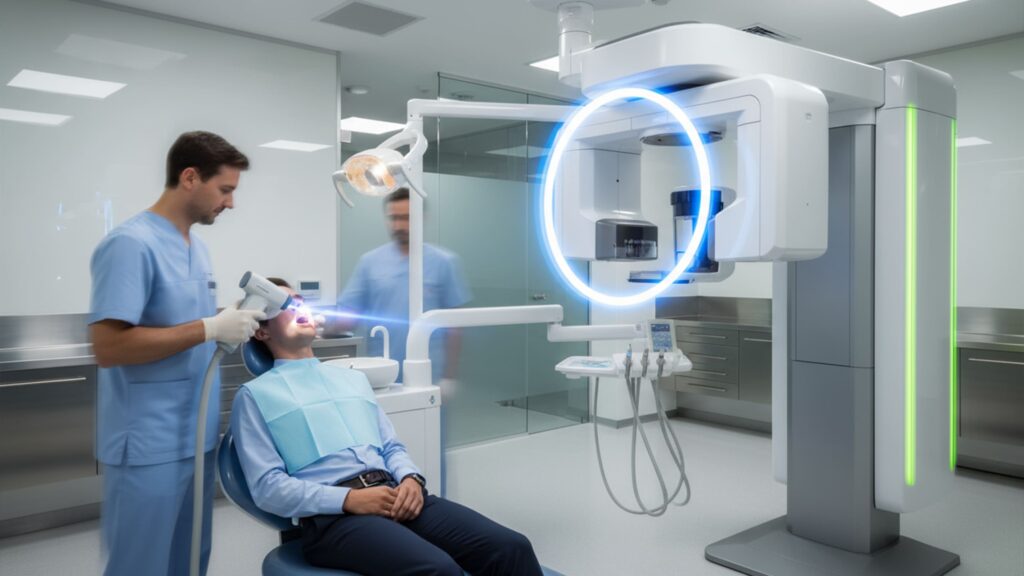Pregnancy is an exciting journey, marked by new priorities, including the health of your teeth and gums. For expecting moms, any mention of the word “radiation” can understandably spark concern, especially when the dentist recommends an X-ray. Dentists, too, often encounter patients with questions and anxieties about the safety of dental imaging during pregnancy. Is it safe? Could it harm the baby? Should X-rays be postponed?
In this blog, we’ve outlined everything you need to know regarding dental radiology procedures during pregnancy.
Safety of Dental Radiographic Procedures
- Dental imaging is generally considered safe during pregnancy when proper radiation protection measures are taken. Modern techniques such as digital sensors, high-speed (F or E-speed) film, rectangular collimation, and optimized radiographic selection criteria minimize exposure. Tarsier X, when used along with digital sensors, helps in the proper positioning of the tube head and consequently minimizes exposure.
- Fetal radiation exposure from dental radiographs is extremely low. For example, the estimated dose for traditional full-mouth intraoral exposure is approximately 0.00001cGy, which is negligible compared to abdominal or chest X-rays.
- The ALARA principle (As Low As Reasonably Achievable) is followed by trained dentists throughout the world, where they aim to avoid retakes, ensure correct technique, and use the fastest image receptors. By using our device, Tarsier X, you can be assured that repeats are avoided by eliminating errors like cone cut.
- Recent recommendations from the ADA and supporting organizations indicate that lead aprons and thyroid collars are no longer routinely recommended for patients, including pregnant women, during dental X-rays if you are using up-to-date digital equipment. Modern technology limits radiation to such a degree that these shields do not provide significant additional protection and may interfere with image capture.
Timing and Indications
- First Trimester: Routine radiographs should be avoided unless necessary, due to organogenesis and higher teratogenic risk. Emergency procedures can be performed with precautions.
- Second Trimester: Considered the safest period for dental radiography, if urgent care is required, as fetal development is more stable and the mother generally feels better.
- Third Trimester: Procedures are possible but may pose more physical discomfort for the mother.

Procedure Selection
- Radiographs should only be taken when clinically justified: for diagnosis, management of pain/infection, or emergencies. Non-radiological investigations should be considered first if feasible.
- Panoramic radiographs and cone-beam CT (CBCT) are generally avoided unless essential, due to higher radiation doses compared to intraoral periapical films.
Patient Communication & Consent
- Dentists must inquire about possible pregnancy in all women of reproductive age and explain risks and protective measures as part of informed consent.
- Clear pregnancy warning signs in waiting rooms and thorough counselling help to address patient anxiety and improve compliance.

Summarizing,
- Dental X-rays are safe in pregnancy with appropriate protection.
- Best timing for necessary imaging: second trimester.
- Use digital receptors, rectangular collimation, and minimize retakes.
- Reserve radiographs for urgent clinical indications.
- Use clear patient communication about safety and protection.
Sources:
- https://pmc.ncbi.nlm.nih.gov/articles/PMC8290609/
- https://www.aapd.org/globalassets/media/policies_guidelines/bp_pregnancy.pdf
- https://www.dental-research.com/idr/article/download/147/77/892
- https://www.iaea.org/resources/rpop/health-professionals/dentistry/pregnant-women
- https://pmc.ncbi.nlm.nih.gov/articles/PMC3681080/
- https://www.shinedental.ca/blog/2025/4/8/understanding-safe-dental-procedures-during- pregnancy
- https://pmc.ncbi.nlm.nih.gov/articles/PMC3429997/
- https://www.acog.org/clinical/clinical-guidance/committee- opinion/articles/2017/10/guidelines-for-diagnostic-imaging-during-pregnancy-and- lactation
- https://www.oraljournal.com/archives/2024/vol10issue3/PartA/10-3-6-396.pdf
- https://www.acog.org/clinical/clinical-guidance/committee-opinion/articles/2013/08/oral- health-care-during-pregnancy-and-through-the-lifespan
- https://www.ada.org/about/press-releases/ada-releases-updated-recommendations-to- enhance-radiography-safety-in-dentistry




